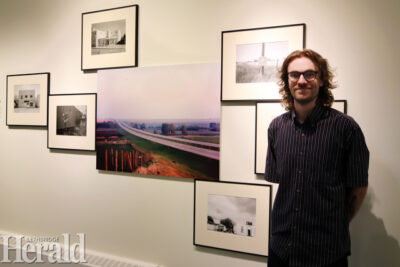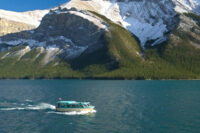Galt exhibit a snapshot of Canadian identity
By Alejandra Pulido-Guzman - Lethbridge Herald on April 17, 2024.
 Herald photo by Alejandra Pulido-Guzman
The Road to L.A.:Reflections on Canadian Identity exhibit by photographer Kort Woycheshin is on display now at the Galt Museum and Archives.
Herald photo by Alejandra Pulido-Guzman
The Road to L.A.:Reflections on Canadian Identity exhibit by photographer Kort Woycheshin is on display now at the Galt Museum and Archives.LETHBRIDGE HERALDapulido@lethbridgeherald.com
A new temporary exhibit at the Galt Museum and Archives will take visitors on a photographic journey of recent history to explore how it has affected certain aspects of the Canadian identity.
The Road to L.A.: Reflections on Canadian Identity, features the work of local photographer Kort Woycheshin through images taken in and around Lethbridge, showcasing Woycheshin’s nostalgic fondness for rural life, along with shifting political views that have altered the concept of Canadian identity as a result of events that took place during the COVID-19 pandemic.
Woycheshin says the project was inspired by signs and slogans he saw along the way while driving between Calgary and Lethbridge during his first few years at the university during the beginning of the COVID-19 pandemic.
Woycheshin is currently completing his final term in the Bachelor of Fine Arts program at the University of Lethbridge.
“It got so bad in terms of the signage popping up that I decided I wanted to document how political division was happening during this time period and how people were expressing themselves in these smaller areas,” said Woycheshin.
He said he believes the exhibit will be well received by many, but he also believes some may see it under a different light.
“I think there’s going to be a lot of people that are going to relate to and hopefully have that reflection moment on their own Canadian identity and where they’re from,” said Woycheshin.
“But I know there’s people who aren’t going to love the work because they’re going to say ‘why are you showing this? You’re platforming these people potentially’ or they may think that I’m on one side, but I am merely here for documentation.”
He said through this project he wanted to explore how the rural identity was shaped by being away from urban centres and wanted to touch on the isolation aspect of it.
“People aren’t experiencing the same things that we are in the city, so they might have different ideologies, they might see different things, or have different opinions and we believe geographic location might have some sort of effect on that,” said Woycheshin.
Woycheshin said what is now on display was originally going to be a much smaller project. But after a year of dialogue, gathering photographs and consultation with instructor and curatorial advisor Katie Bruce and museum’s curator Tyler Stewart, the original project evolved into what visitors can see on the walls of the main gallery.
“It’s pretty insane, not often in university, especially in your undergraduate experience to have a full year to work on something never happens, it’s usually three weeks. To see it all come together is pretty surreal and to know that my work it’s all over this giant space is pretty amazing,” said Woycheshin.
The exhibit is showcased in sections, which include one about flags and Woycheshin said he wanted to explore how the connection with the Canadian flag may have changed for some – including himself – after being used in the Coutts blockade.
“I wasn’t really sure about how I felt about the Canadian flag, it had this new meaning for me, it didn’t really mean Canada as I had known it as a kid, to be this big beautiful multicultural place, it kind of became a polarizing symbol to some extent,” said Woycheshin.
 Another section of the exhibit explores the slogans and ways people expressed themselves about the COVID-19 pandemic.
 “Slogans is the biggest category, it is just how people wanted to express their opinions in different ways and I wanted to play on how I might interpret those slogans and how I can capture them photographically, place them next to each other, what kind of context can you get when you bring the slogans all together,” said Woycheshin.
A section that has more than one layer of symbolism is named Choices and Woycheshin explained how the way he decided to capture his images ties into the exhibit itself.
 “This one is about my analog photography journey and the choice to use analog, why that’s important and then also add this subtlety of how you have choice on your ideologies, you have choice in your beliefs. I chose this medium and you can choose whatever you like,” said Woycheshin.
The exhibit will be officially launched Friday with a launch party that will also celebrate another exhibit that showcases photographs from local history, the Extra! Extra! Eras of Photojournalism in Lethbridge.
“The event will have a bit of a dialogue between the artists and curators involved in both projects to talk about how photos and documentary work and photojournalism is shaping how we perceive the world around us,” said Tyler Stewart, curator for the Galt Museum and Archives.
 He said often people think about how history is something that is in the past, but history is happening right now and the exhibits showcase just that.
“I think 10 or 20 years from now we’ll go back and think about the COVID-19 pandemic and how the way we perceived the nation of Canada has changed and that’s going to be a big moment in history, but we’re kind of still living inside of it right now,” said Stewart.
 He said it is important for the museum to look at history not just as things that happened 100 years ago, but things that are happening right now and connecting those two things together.
 The launch party will take place Friday from 6 to 9 p.m. at the Galt Museum and Archives.
26-25




